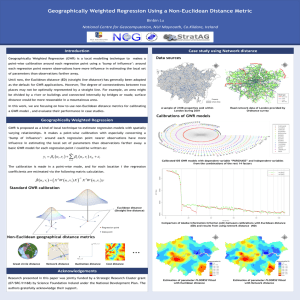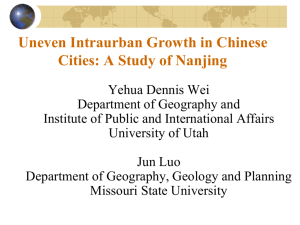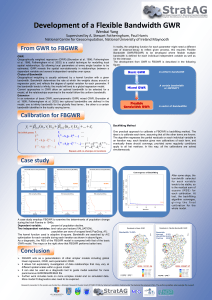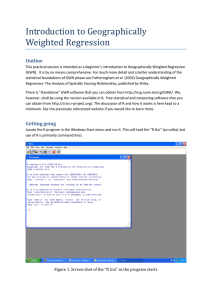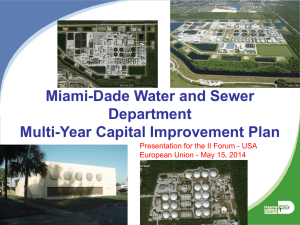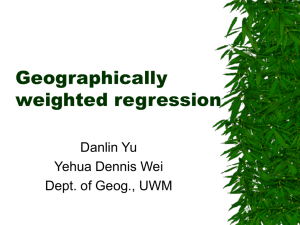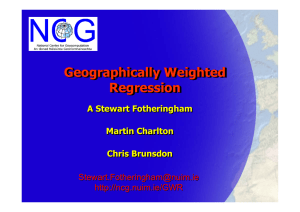Assessment of the effects of greywater reuse on gross solids
advertisement
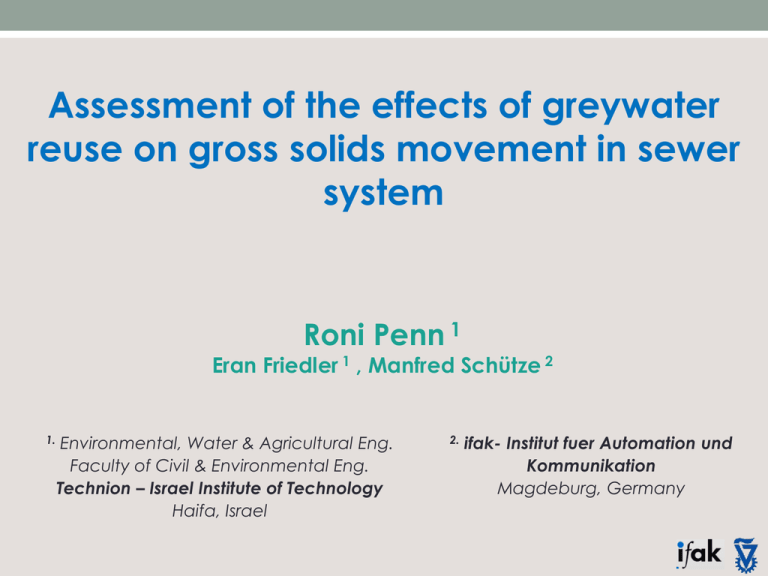
Assessment of the effects of greywater reuse on gross solids movement in sewer system Roni Penn 1 Eran Friedler 1 , Manfred Schütze 2 1. Environmental, Water & Agricultural Eng. Faculty of Civil & Environmental Eng. Technion – Israel Institute of Technology Haifa, Israel 2. ifak- Institut fuer Automation und Kommunikation Magdeburg, Germany 1 Introduction Shortage of fresh water is a serious worldwide problem Urban consumption (Israel) Over 700*106 m3/year- The sector consuming the largest amount of freshwater 70% Domestic consumption 60-70% 30-40% Greywater (GW) Blackwater Toilets Light Bath Shower Washbasin Dark Kitchen sink Dishwasher Washing machine? Potential reduction of GWR Toilet ~ 30% Toilet +garden irrigation ~ 40% 2 Introduction GWR research focused, on a single-house scale, on recycling systems and possible sanitary and environmental affects. Effects on domestic WW quantity and quality, on urban wastewater collection systems and on urban wastewater treatment plants (WWTP) overlooked Questions to be asked: • What could be the effects of GWR on urban WW collection systems and on WWTPs? • Are these effects positive or negative? • How will they change with increasing penetration of on-site GWR? 3 Introduction GW can contain non negligible concentrations of organic and microbial contamination. Treatment of GW before reuse • Prevent sanitary and environmental hazards • Prevent aesthetic disturbance Within the urban environment, GW "demand" < GW "production" Treat and reuse the less polluted GW streams (SH, BT and WB) The more polluted discharge to the urban sewer system 4 Types of homes contributing WW “GWR” home “Conventional” home B A Selected for reuse GW Source GW Source GW Source Not reused GW Source GW Source Not reused GW Source GW Source GW Source GW Source GW Source Toilet flushing Toilet flushing Blackwater Blackwater On-site Raw GW treatment Overflow Sludge Scum etc WWTP WWTP Garden irrig. Sewer Sewer 5 6 Effect of GWR- quantity and quality effects Quantity effects Wastewater flows released to the sewer reduced wastewater flows in the sewer network reduced wastewater flows to the WWTP reduced Quality effects Treatment changes the quality of the wastewater discharged to the urban sewer Reduced flows (less dilution?) 7 The chosen neighborhood 15,000 residents Flat densely populated coastal area neighborhoods sewer pipes ~ 6 km Separate sewer 7 Scenarios examined Current situation GWR type & penetration proportion (1) NR (2) RWC (3) RWC+IR Extreme situation To be expected 1 2 3 4 5 100% 0% 0% 70% 70% 0% 100% 0% 30% 15% 0% 0% 100% 0% 15% Separate sewer systems, Effects of GWR on: Sludge released at 8:00, • Flow characteristics • Gross solids movement sewer blockages? Toilet flush volume: (1) 9L full, 6L half (2) 6L full, 3L half Diurnal pattern LINK 36 FLOW [m3/min] 0.08 0.07 0.06 PROPORTIONAL VELOCITY DEPTH (d/D) [-] [m/s] LINK 154 5 5 5 4.5 4.5 4.5 4 4 4 3.5 3.5 3.5 0.05 3 3 3 0.04 2.5 2.5 2.5 2 2 2 1.5 1.5 1.5 1 1 0.01 1 0.1 0.5 0 5 0.5 0.5 1.40 0 1.4 0 1.4 0 1.4 1.2 1.2 1.2 1.2 0.03 0.02 FROUDE [-] LINK 71 LINK 97 1 1 1 1 0.8 0.8 0.8 0.8 0.6 0.6 0.6 0.6 0.4 0.4 0.4 0.4 0.2 0.2 0.2 0.2 0 0.7 0 0.7 0 0.7 0 0.7 0.6 0.6 0.6 0.6 0.5 0.5 0.5 0.5 0.4 0.4 0.4 0.4 0.3 0.3 0.3 0.3 0.2 0.2 0.2 0.2 0.1 0.1 0.1 0.1 0 1.4 0 1.4 0 1.4 0 1.4 1.2 1.2 1.2 1.2 1 1 1 1 0.8 0.8 0.8 0.8 0.6 0.6 0.6 0.6 0.4 0.4 0.4 0.4 0.2 0.2 0.2 0 0 4 8 12 16 20 24 T [h] 0 0 4 8 12 16 20 24 T [h] 0 0 0.2 4 8 12 16 20 24 T [h] 0 0 4 8 12 16 20 24 T [h] 9 Gross solid transport GWR domestic WW - reduces flows with in the sewer system – reduced higher rate of blockages? Upstream Downstream Flow Intermittent More steady Solids Larger, un-submerged Smaller, submerged different approaches for each part of the sewer: Upstream: based on model by Walslki et al., 2011. Downstream: based on model based on tractive force (TF) (Walski et al., 2004.) 10 Gross solid transport – upstream (Walslki et al., 2011) Pulse to move solid with attenuation, short duration Flow to move solid no attenuation, long duration 𝑽 = 𝒂𝑺𝑮/𝑺𝟎.𝟐 𝟎.𝟐 𝑸 = 𝒂𝑺𝑮/𝑺 SG Q a specific gravity flow (L/s) 0.45: full - partial movement 0.25: no movement - partial movement S V a slope of pipe volume of pulse (L) 18: full - partial movement 11 10: no movement - partial movement 84 83 8 2 81 80 79 78 77 76 Ori fice Orif ice e 154 e ific Or 154 Outlet pipe 85 71 0.85 0.05 0.1 0.78 0.03 0.19 12 5 11 11 3 2 99 10 0 98 27 28 26 𝟑× 24 21 59 58 22 20 57 56 19 55 5 3 2 85 695 68 1 67 50 52 4 85 48 0.78 0.04 0.17 0.66 0.1 0.24 48 45 46 47 49 1 8484 81 80 81 79 83 82 83 82 80 79 78 77 76 75 74 73 11 10 9 33 32 12 34 8 13 23 35 31 108 14 109 22 7 107 30 16 15 21 6 106 17 29 123 20 28 5 105 27 4 19 104 122 103 3 26 121 18 129 102 120 2 1 25 101 128 119 127 100 24 118 126 99 117 54 53 98 55 116 56 97 52 57 62 61 60 115 59 58 69 96 68 51 114 95 67 50 113 66 112 94 153 49 93 92 7065 152 91 151 64 150 90 48 45 149 146 46 63 148 8988 47 147 145 87 144139 86 143 138 142 137 140 141 136 135134 133 132 131 130 125 72 71 111 110 124 44 4 3 42 41 40 39 38 0 0.14 0.86 63 6 54 53 7 66 65 70 64 18 8 11 10 9 85 flow n i a M tion c e r di 94 1 15 5933 92 91 15 2 15 1 90 14 104 14 9 6 89 88 14 8 1 7 45 87 14 13 86 9 4 14 13 3 8 14 13 14 2 7 01 41 13 6 13 13 5 4 13 13 3 13 2 13 1 0 62 61 60 97 96 95 97 25 14 13 23 12 154 57 11 4 ce 44 43 41 40 39 37 42 38 37 36 0.11 0.38 0.51 11 5 11 6 11 7 11 8 11 9 Orifi 0 0.06 0.94 12 6 12 7 12 8 10 4 10 3 10 2 10 1 107 1 12 21 912 0 4 30 15 16 17 29 31 15 0.28 0.39 0.33 12 2 4 85 33 3 2 15 4 15 0.02 0.22 0.76 34 35 10 10 8 75 1 91 72 71 11 10 07 74 7 12 1 3 10 4 6 12 3 10 5 ific Or 0.18 0.36 0.46 36 Gross solid transport - upstream 0.27 0.38 0.35 36 0.02 0.21 0.77 𝟑. 𝟓 × Main flow 0.82 0.05 direction 0.13 0.75 0.03 0.21 Gross solid transport - downstream Average boundary tractive stress Critical Tractive Force TF (Walski et al., 2004) 𝝉 = 𝝆𝒈𝑹 𝑺 𝟏𝟎𝟎 𝝉𝒄 = 𝒌𝒅𝟎.𝟐𝟕𝟕 𝝉 tractive stress (Pa), 𝝆 density of liquid (kg/m3) R hydraulic radius (m) K d • For: discrete grit particle • Transported often enough 0.867 (N/m2) diameter (mm) for a discrete design sand particle of 2.7 specific gravity d=6mm 𝝆=1000 𝒌𝒈/𝒎𝟑 13 Modeling gross solid transport Generator module Velocity SIMBA Conclusions GWR: toilet flushing: saves ~25% of the water consumption GWR: toilet flushing & irrigation: saves ~40% Higher GWR: •Instantaneous: Q, V, (d/D) decrease Highest reduction – peak usage hours • d/D decrease connect additional homes to existing sewers construct smaller systems Gross solid transport: Upstream links Small amounts of WW discharged Middle links additional houses discharge WW Higher proportions of no GWR GWR the day for full 67% of the day 76% of the day movement full / partial no movement movement Downstream links full movement in all scenarios THANKS FOR LISTENING! QUESTIONS? 16
